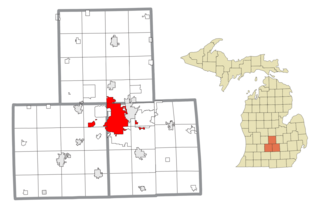
Lansing is the capital of the U.S. state of Michigan. It is mostly in Ingham County, although portions of the city extend west into Eaton County and north into Clinton County. The 2020 census placed the city's population at 112,644, making it the sixth largest city in Michigan. The population of its metropolitan statistical area (MSA) was 541,297 at the 2020 census, the third largest in the state after metropolitan Detroit and Grand Rapids. It was named the new state capital of Michigan in 1847, ten years after Michigan became a state.
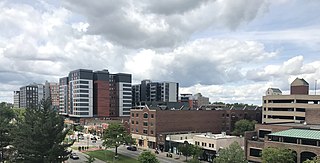
East Lansing is a city in the U.S. state of Michigan. Most of the city lies within Ingham County with a smaller portion extending north into Clinton County. At the 2020 Census the population was 47,741. Located directly east of the state capital of Lansing, East Lansing is well-known as the home of Michigan State University. The city is part of the Lansing–East Lansing metropolitan area.

Michigan State University is a public land-grant research university in East Lansing, Michigan. It was founded in 1855 as the Agricultural College of the State of Michigan, the first of its kind in the United States. After the introduction of the Morrill Act in 1862, the state designated the college a land-grant institution in 1863, making it the first of the land-grant colleges in the United States. The college became coeducational in 1870. In 1955, the state officially made the college a university, and the current name, Michigan State University, was adopted in 1964. Today, Michigan State is one of the largest universities in the United States and has approximately 634,300 living alumni worldwide.

The Red Cedar River is a tributary of the Grand River in central Michigan in the United States. The river is approximately 51.1 miles (82.2 km) long and drains a watershed of approximately 461 square miles (1,190 km2) in the Lansing–East Lansing metropolitan area and suburban and rural areas to the east.

Sparty is the mascot of Michigan State University. Sparty is usually depicted as a muscular male Spartan warrior/athlete dressed in stylized Greek costume. After changing the team name from "Aggies" to "Spartans" in 1925, various incarnations of a Spartan warrior with a prominent chin appeared at university events and in university literature. In 1943, MSU art professor Leonard D. Jungwirth designed a statue for the university, which had to be cast in terra cotta because of World War II rationing. In 2005, the university replaced Jungwirth's original statue with a bronze replica, moving the original indoors to protect it from the elements.
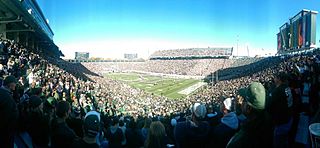
Spartan Stadium , nicknamed "The Woodshed", opened in 1923 in East Lansing, Michigan, United States. It is primarily used for football, and is the home field of the Michigan State University Spartans. After the addition of luxury boxes and club seating in 2004–2005, the capacity of the stadium grew from 72,027 to 75,005—though it has held more than 80,000 fans—making it the Big Ten's sixth largest stadium.
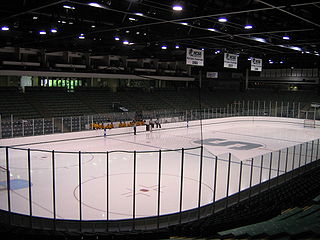
Clarence L. Munn Ice Arena is a 6,114-seat hockey-only arena in East Lansing, Michigan on the campus of Michigan State University, situated across Chestnut Road from the Intramural Recreative Sports Center West and Spartan Stadium. It is home to the MSU's ice hockey team. Completed in 1974, the arena is named in honor of former MSU football coach and athletic director Clarence "Biggie" Munn.

Saints' Rest was the second building erected on the campus of the Agricultural College of the State of Michigan. It was built in 1856 and served as the school's only dormitory until 1870, when Williams Hall was completed. Along with College Hall and a horse barn, it was one of three buildings completed when the college opened for classes in 1857.
WKAR-TV is a PBS member television station licensed to East Lansing, Michigan, United States, serving the Central Lower Peninsula of Michigan. The station is owned by Michigan State University and operated as part of its Broadcasting Services Division. WKAR-TV's studios are located in the Communication Arts and Sciences Building, at the southeast corner of Wilson and Red Cedar Roads on the MSU campus in East Lansing. Its transmitter is located on Kinawa Road in Meridian Township, Michigan between East Lansing and Williamston.
The history of Michigan State University dates back to 1855, when the Michigan Legislature established the Agricultural College of the State of Michigan under the encouragement of the Michigan State Agricultural Society and the Michigan Farmer, the state's leading agricultural periodical. As the first agricultural college in the United States, the school served as a model for other institutions of its kind established in the period, to give an instance, the Agricultural College of Pennsylvania.
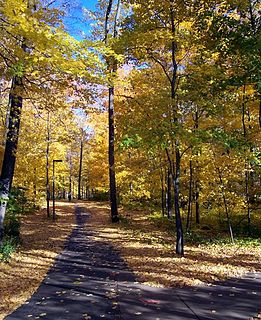
The campus of Michigan State University is located in East Lansing on the banks of the Red Cedar River, and comprises a contiguous area of 5,200 acres (21 km2), 2,000 acres (8.1 km2) of which are developed. Built amid virgin forest, the campus opened in 1855 with three buildings, none of which remain. As an agricultural college, the campus was originally located several miles outside of the city of Lansing, but as the population of the college grew, the city of East Lansing developed just north of the area's main avenue.

Michigan State University (MSU) offers over 200 academic programs at its East Lansing, Michigan campus. MSU is well known for its academic programs in education and agriculture, and the university pioneered the studies of packaging, horticulture and music therapy. MSU has one of the premier hospitality schools in the United States, and the study abroad program is one of the largest of any university in the nation, offering more than 300 programs in more than 60 countries on all continents, including Antarctica. MSU's Office of the University Ombudsperson is the oldest continually operating ombudsman office at a college or university in the country.

The Michigan State University College of Human Medicine (MSUCHM) is an academic division of Michigan State University (MSU), and grants the Doctor of Medicine (MD) degree. CHM was founded in 1964 as the first community-integrated medical school, and has a program that emphasizes patient-centered care and a biopsychosocial approach to caring for patients. Required courses at the college reinforce the importance of ethics and professionalism in medicine. In 2013, U.S. News & World Report ranked the college 46th for primary care. The college was also ranked for family medicine and rural medicine. More than 4,000 M.D.s have graduated from the College. Pre-clinical campuses are located on MSU's main campus in East Lansing, Michigan and in downtown Grand Rapids, Michigan, while the clinical rotations are at seven community campuses located throughout Michigan.

The Michigan State Spartans football program (MSU) represents Michigan State University in college football at the NCAA Division I Football Bowl Subdivision level. The Spartans are members of the Big Ten Conference. Michigan State claims a total of six national championships. The Spartans have also won eleven conference championships, with two in Michigan Intercollegiate Athletic Association and nine in the Big Ten.
Michigan State University Housing is a large and complex network of housing for students and faculty of Michigan State University. Most of the housing is in the form of residence halls on the school's campus, but there are also university apartments, fraternity and sorority housing, and free-standing housing for grad students, faculty and staff.

The Michigan State Spartans men's ice hockey team is the college ice hockey team that represents Michigan State University (MSU). The team plays at the Munn Ice Arena in East Lansing, Michigan, on the MSU campus. The current head coach is Adam Nightingale, who took over coaching duties on May 3, 2022, after Danton Cole was fired. Michigan State currently competes in the Big Ten Conference.
Cedar Fest was a celebration held in East Lansing, Michigan. The event, which started in the 1970s, was started by Paul Stanley who was the head of pop entertainment which was Michigan State University‘s student entertainment board. Pop entertainment had made a large sum of money that year and it was a means that Paul created to basically give back to the students. Cedar fest was to be a beautiful spring day down by the Cedar River with live known bands. The first year hosted mainly folk guitar acts and drew around 8000 students that enjoyed the beautiful day at the Cedar River. The following year cedar fest Drew approximately 10,000 to 12,000 people to The cedar river banks for the concert. The event was held in Cedar Village, a densely populated student neighborhood bordering the Michigan State University campus. The event took off in the 1980s and was regularly attended by thousands. Several riots ensued from the parties and property owners along with the city decided to put an end to the event. In 1987 the event was banned by an injunctive order issued by Judge Carolyn Stell. For many years it was not held.
The Izzone is the Michigan State University men's basketball team student section organized and run by the Athletic Marketing Department at Michigan State University. Named after head coach Tom Izzo, the Izzone consists of nearly 5,000 members, seated in both the lower and upper bowls of the Breslin Center. With close to 5,000 members cheering on the MSU Men's Basketball team, the Izzone helps give the Breslin Center an exciting and intimidating atmosphere, and a considerable home-court advantage.
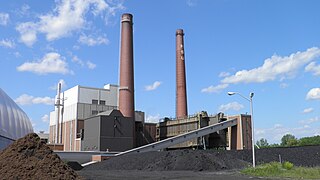
T.B. Simon Power Plant is a multi-fuel cogeneration facility located on the East Lansing campus of Michigan State University. With a peak electrical output of 99.3 megawatts and a pressurized steam generation capacity of 1.3 million pounds per hour, it is one of the 500 largest power plants. The Simon Power Plant is the principal energy provider to the 45,000-student main campus, meeting approximately 97% of all energy demand. Pressurized steam is distributed throughout the campus through an extensive network of tunnels to provide both heating and cooling to approximately 500 instructional, research, and residential buildings located on more than 5,000 acres (2,000 ha). Electrical power is distributed through the same tunnels, making the campus relatively immune from outages due to weather. The primary fuel for T. B. Simon is natural gas; with the 1993 addition of Unit No. 4 the plant acquired the capability of burning biofuel. Simon's east smokestack identifies its operator with the letters M S U in white brick.
The 2016–17 Michigan State Spartans men's basketball team represented Michigan State University in the 2016–17 NCAA Division I men's basketball season. The Spartans, led by 22nd-year head coach Tom Izzo, played their home games at the Breslin Center in East Lansing, Michigan and were members of the Big Ten Conference.